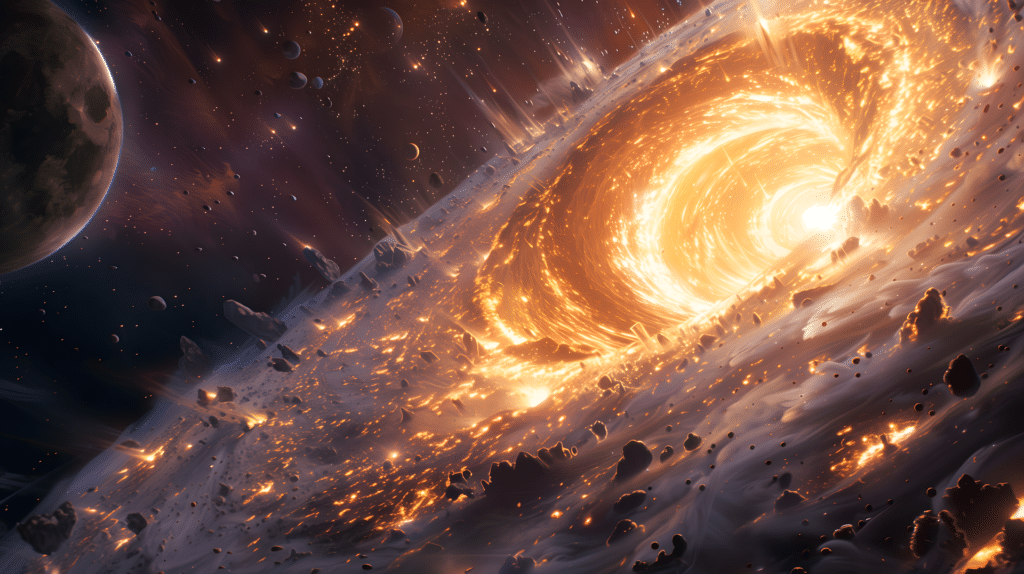
Collapse of “parts of space-time” could explain dark matter and the “whisper” of the universe
⇧ [VIDÉO] You may also like this partner content
In astrophysics, there are what are called “domain walls”. These hypothetical structures are “enormous sheets of space-time” separating different regions of the universe. In a new study, it is suggested that these elements appeared and disappeared immediately after the Big Bang, and thus could be the origin of low-frequency gravitational waves, certain types of black holes, and even partly explain dark matter.
Domain walls are taken into account in theories that aim to explain some unresolved phenomena in astrophysics, such as the origin of gravity and other fundamental forces. According to some researchers, if domain walls persist in the universe, they could be a major source of energy and influence the overall evolution of the universe. They add that if that were the case, we would be able to observe evidence of its existence or effects today. However, there is no direct evidence to support their existence.
In a new study published on a preprint server
arXivA group of researchers led by Ricardo Ferreira, a cosmologist at the University of Coimbra in Portugal, suggests that the wall domains that formed shortly after the Big Bang grew rapidly, and then mostly destroyed themselves in a very short time. However, its brief existence would have caused noticeable disturbances in space-time. In addition, according to the study, some of the domain walls that did not completely collapse may have turned into black holes. These could be numerous enough to constitute a significant fraction of the dark matter.
Breaking symmetry
According to many researchers, the Standard Model of particle physics (the theoretical framework that explains the interactions of elementary particles through fundamental forces) suffers from flaws. Moreover, it does not explain some cosmic phenomena.
To address this problem, physicists in the new study proposed expansions of the Standard Model by introducing “symmetry breaking.” This is the process by which uniform conditions begin to differentiate as the universe cools and expands. Transformation can lead to the creation of stable and distinct (initially unified) cosmic structures. As part of an extension of the Standard Model, domain walls are considered here as a result of symmetry breaking. They are conceived as barriers between different “stages” of the universe, during this transformation.
Gravitational waves
In this study, the researchers focused on a version of symmetry breaking that was theoretically produced in the initial conditions of the universe, immediately after the Big Bang, when the temperature was about 2 trillion degrees Celsius. The team used computer simulations to model and visualize the evolution of domain walls under this symmetry breaking. By rising and then collapsing, these pieces of space-time generate disturbances called “random gravitational waves,” which can propagate across the universe.
See also

As time passes and the universe continues to expand, the gravitational waves emanating from these band walls extend to longer and longer wavelengths (and thus at lower and lower frequencies). Today they would have frequencies in the nanohertz range, consistent with the background of gravitational waves recently discovered by exploiting millisecond pulsars (neutron stars spinning very rapidly on themselves, up to several hundred revolutions per second). However, the exact origin of these waves remains a subject of active research.
Are domain walls the reason for the existence of certain black holes?
According to the latest analysis, not all of the domain walls formed after the Big Bang collapsed. Some of them survived thanks to a kind of space-time “bubble” larger than the radius of the visible universe at that time. Thus, as the universe expands, these walls will eventually become part of the observable universe, where they will appear as regions of abnormally high energy density. These “hyperdensities,” as researchers call them, can collapse under their own gravity to form black holes. The latter are called “primordial,” because they therefore result from phenomena that occurred shortly after the Big Bang, and not from the collapse of large stars. Primordial black holes generated by this hypothetical mechanism would have a low mass (for black holes), only a few times the mass of the Sun.
source : arXiv

“Organizer. Social media geek. General communicator. Bacon scholar. Proud pop culture trailblazer.”
